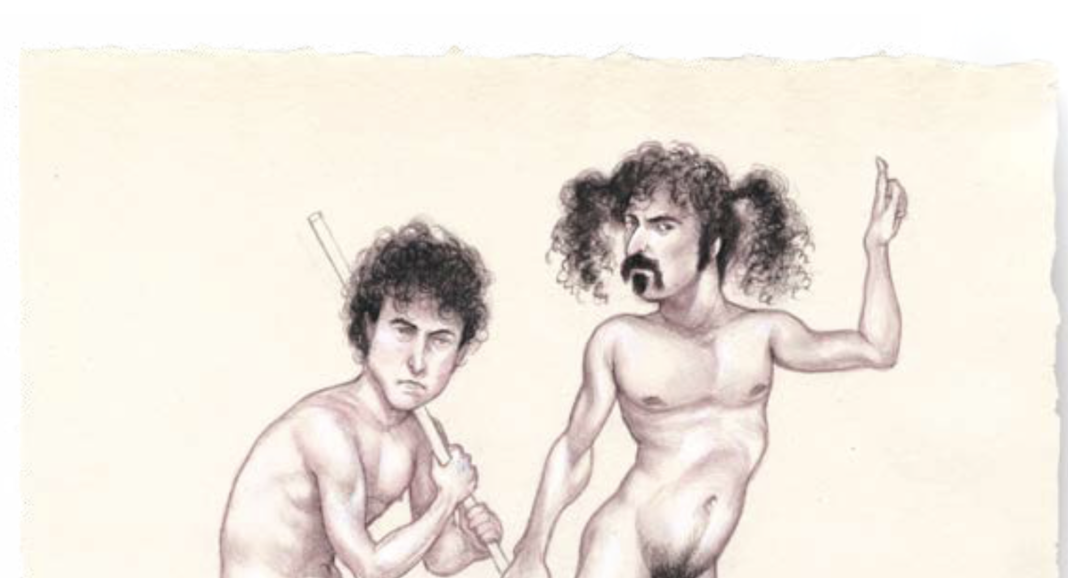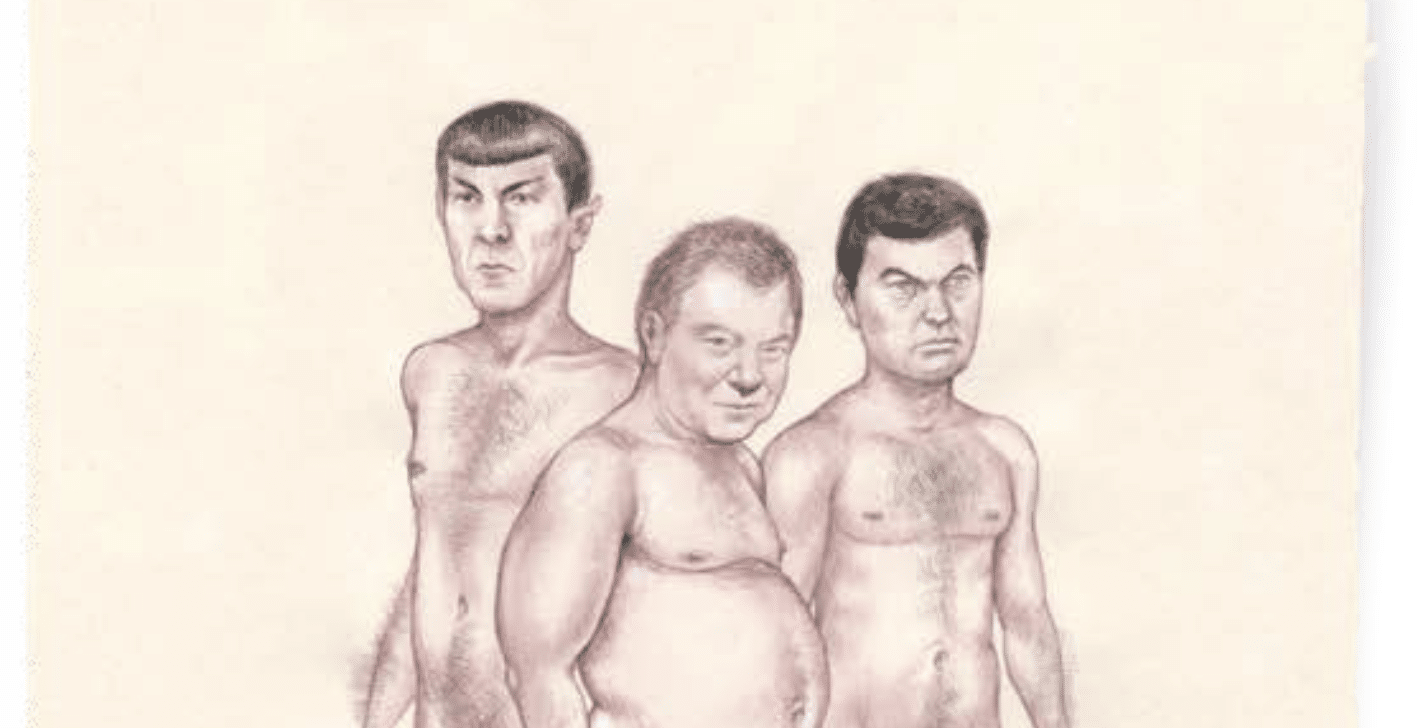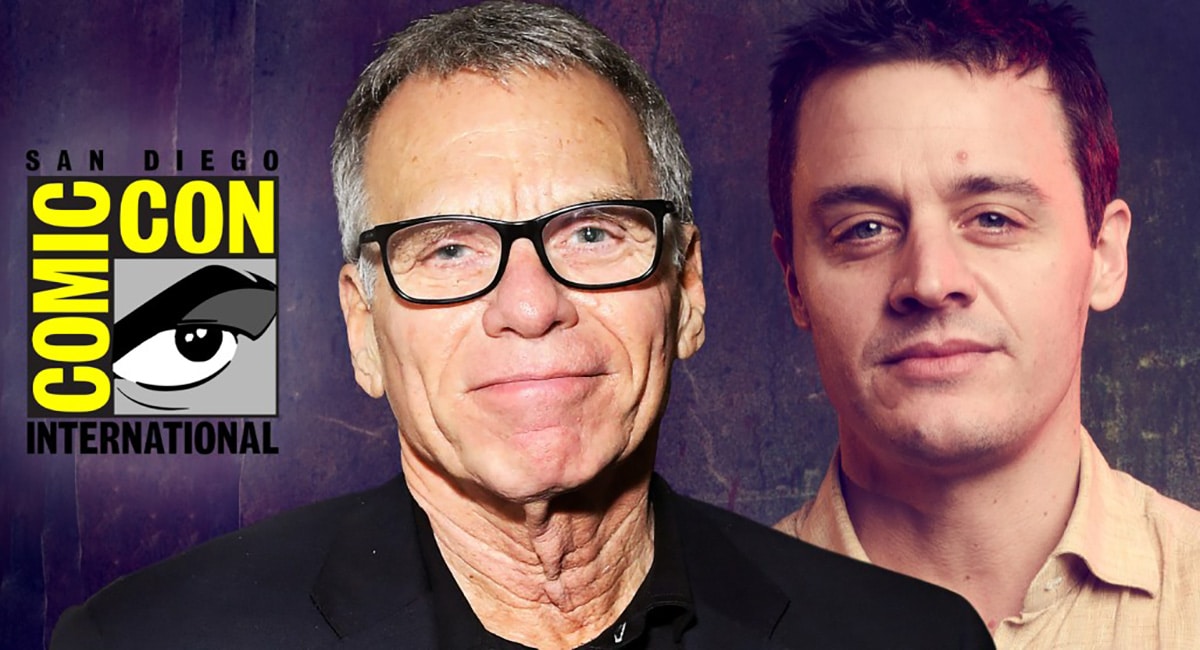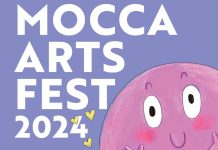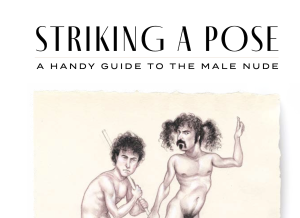
In Striking A Pose: A Handy Guide to the Male Nude by Anita Kunz, available now from Fantagraphics, over a hundred pop culture icons are depicted as though they have posed for your Live Drawing Class.
The Beat caught up with Kunz to celebrate the release of Striking A Pose. We learned all about the paper-based origins of the book, asked about the selection of hypothetical models chosen, and discovered what went into bringing the project to your local bookstore and/or public library.
AVERY KAPLAN: Can you tell us about the origins of the book?
ANITA KUNZ: I did something already in New York and people were asking me questions. And I had to really think, because I did most of them about 15 years ago.
The origins of the book were: I have a really good friend named Maurice Vellekoop. I don’t know if you know his work. He’s amazing. And he’s one of my best friends. He’s written a book called I’m So Glad We Had This Time Together. It’s coming out in the spring. And it’s basically about growing up gay, in a very religious background.
Anyway, so he’s done all this incredible gay erotica for for decades. And the two of us were offered a two person show. And so we did a show. So he had all of his sort of male nudes. And I did a whole bunch of male nudes. His were more erotic and mine were more academic. And mine were based on my experience as an artist and as an art teacher, and my years of teaching nude life drawing and also doing nude life drawing.
So it all it all that was the genesis of it, that was the start of it. And then we just took it from there, it was a really fun show. And then after that, I started building on it. And there were just sort of more and more of them. And then I had little shows, and then Fantagraphics said they would do a book, which was amazing. They’re amazing.
But the other thing, most of my work is really colorful, and you know, paintings. But I was given a whole bunch of really nice paper. And I thought, “What am I going to do with this paper?” And I thought, “If I could approach these nudes like they were sketchbooks, like I was doing real life drawing, then I could use the paper and use it in such a way that it would look like a sketchbook.” So that was how the whole thing started.
That was that was actually a really big part of it was this gorgeous watercolor paper I got. Acid free. And I thought, “I’ve got a whole bunch more, I don’t know what I’m gonna do with it. I was given all of this beautiful paper.” So I’m still trying to figure out what else to do with it.
KAPLAN: Can you tell us a bit about how your art students’ “triumphs and struggles with nude life drawing” inspired Striking A Pose?
KUNZ: I think personally, that life drawing is one of the most important ways to learn how to draw, especially the way that the way that students typically draw. When I teach them, first what we do is we have the person up there. And then the first thing you do is you do like, one minute drawing, then five minute drawing, and then 10 minute drawing, and then there’s like a full half hour pose or two hour pose or whatever.
And the reason that we even do life drawing is so that so that so that you can understand anatomy. And so if the person is moving around with all these different poses, you can sort of begin to understand: “Okay, this is how the body works.” So it’s all very academic, but it helps students later on.
First of all, it helps with hand to eye coordination. You know, if you’re a writer, if you don’t have a background knowledge of grammar, forget it. It’s really important. I think if you want to be an illustrator, it’s really important to have a basic understanding and to be good at drawing, because that’s the only way that you can get your ideas down. And it’s really important to just understand human anatomy, so that then you can take that framework. And then when you’re actually doing paintings or illustrations or whatever it is, you have the basic structure so that you can work and not struggle too much.
But it’s hard. You know, most of my most of my students have said that, it’s hard. And it’s hard sometimes to do a gesture in a really short period of time. But it’s kind of the only way to learn. And then later, somebody like me, I’ve been an illustrator for decades. And a lot of times, you’re on a deadline, somebody wants you to draw something or somebody. And so you have to draw out from your head. And that’s why you have to have this knowledge, and you have to already know what something looks like. Otherwise, it’s gonna look weird. You have to have a basic understanding.
So that’s sort of where that’s the whole point of life drawing. But, it is kind of weird. I realized that this book, if you’re not an artist, or if you don’t know what life drawing is, or if you haven’t experienced it, it’s probably seems really weird that you actually draw naked people.
The first day of class, it’s weird, because the students—half of them are young, half of them are 18. And they come in, and it takes a while to wrap your head around it. By the next class, it’s no big deal, it becomes kind of stale. Which is kind of hilarious, because sometimes a person will walk around nude, and it very quickly becomes no big deal. And it very quickly becomes just about anatomy.
KAPLAN: Can you tell us about your creative routine for this book, if you had one?
KUNZ: For Strinking A Pose? Um, again, this was 15 years ago. Usually when I work on a bigger project, one that’s not just one picture, I usually try to have some kind of a schedule. So I’ll try to do one a day.
And that’s kind of what I did through the pandemic. I thought, “At least if I can do one a day, then at least I’ve done something,” you know, haven’t just sat sat there and watched Netflix. So I tried to give myself a schedule. So that’s basically what it was.
And the way that I picked the subjects. I mean, a lot of them are from growing up. A lot of the subjects, especially the musicians, are people I listened to, like the new wave bands. It has to do with politics. I mean, I think you can sort of tell the ones I like and the ones I’m not so crazy about, you know what I mean?
So, some of them are a little more exaggerated, but for the most part, I just pretty much drew them as if they were in class. The poses in life drawing are a little silly sometimes, like they’ll be standing there with [mimes pose]. But, that’s kind of how you learn, right?
But the way that I did it, I drew them from my head. This is the whole point of life drawing, is that so you can then use that knowledge later on in your career. But the way that I got reference is, at art schools, you can get these photo reference books. And that’s what artists have used for forever. And I still have old books like that, that I used. So I just kind of made up the figures.
I started out doing just one per page. And then I thought, well, as a book, that doesn’t flow very nicely. So I started doing two or three at a time, like the “The Space Explorers” [pictured below].
I put William Shatner in because he’s Canadian. So there you go. He’s a very proud Canadian. We’re very, very proud.
KAPLAN: How did you decide the order of the sketches featured in the book?
KUNZ: I don’t know, I’m not even sure I did. I think they may have done that. But I could be wrong. But the order doesn’t really matter.
I mean, it’s kind of a mix and match, you know. It was important for me to have people from the past and current people. I think I’ve got Aristotle, all these really old people, Plato.
KAPLAN: You’ve got both Charles Dickens and Stephen King.
KUNZ: Yes, exactly. I just thought that would be more interesting. And I didn’t want them all to be white. There was diversity, and that became important too.
KAPLAN: Did any sketches not make the cut? Was there anyone who you were particularly excited to include?
KUNZ: Not really. No. And of course, I did some and then people died in the meantime, because it was a 15-year project. A lot of them I did with great affection, except for some of them. You can tell, most of them, I did them with love, right? Because it was originally for Pride. So the whole thing was about celebration, about celebrating the male nude.
But it’s very interesting: when I was in New York, I did a book signing, and I had a couple of questions that I thought, “Wow.” There were two guys. One guy said, “So is this some kind of propaganda?” And I thought, “What am I propaganda-ing?” I thought that was a really weird question.
And then somebody else asked me if I’m trying to get revenge. And I thought, “Revenge from what?” I think they kind of miss the spirit of it. You know, it’s satirical. And no revenge. But I don’t know. It just was kind of weird. They thought it was trying to be mean. And I wasn’t trying to be mean at all. But sometimes people misunderstand intentions. I guess it will happen.
KAPLAN: Those are both such strange responses. Propaganda?
KUNZ: I’m always kind of poking at the patriarchy. I’ll be honest, my last Fantagraphics book was like that, too. There’s a little challenge there. But for the most part, I really get into the drawings and I love drawing them, and I love doing detailed drawings. And so for the most part, it was very positive.
But it’s always like that. People see through things through the lens of their own experience. And the whole propaganda thing. Well, some of the best art… Pablo Picasso‘s Guernica was was anti-Nazi. That’s propaganda.
KAPLAN: Was there anyone that you realized you wished you’d included once it was two late?
KUNZ: No, because I was doing them right up until the last minute. I think I did Elton John last, right up until I couldn’t do any any more. But there’s a deadline, and what can you do? Volume Two? Maybe, hopefully, you never know.
KAPLAN: I am curious how you perceive the relationship between Striking A Pose and your previous title of Fantagraphics, Another History of Art? How do the pair relate, if they relate?
KUNZ: Well, they sort of don’t. I work in different areas.
The first Fantagraphics book, Another History of Art. In school, and in the illustration field, it really is white male dominated. They were talking about, “here is that the history of art,” and I thought, “maybe let’s call this the history of white, European art, let’s do that.” And then that’s not the history of art, there are many histories of art.
So that was kind of the point of the book: this is another History of Art. This was an imaginary take on some of these amazing, iconic paintings. And I love these paintings. But if I had done them, what would it look like? And again, it’s satire, it’s not supposed to be really serious. I just asked, “What if?”
And after I did the paintings, I looked at the biographies of the artists, and I thought, “If I change the gender, what happens here?” And what happened was, you sort of get the understanding that there’s no way that a woman could have done this. Everything would have been against the women then. And when there were a great female artists, then they just wouldn’t have been recognized. So that was kind of the point of Another History of Art. You know, again, a little poke at the patriarchy.
But I really loved painting the paintings. You know, when I experimented with them with that book, some of them are really big. And it’s satire, there’s an underlying point, but I just had a really nice time painting them.
Now I’m working on another book. So we’ll see how maybe Fantagraphics will like it, but this one is about allegories, fables. But if the fables were now in this era that we’re living, so it kind of has to do with climate change and OSHA. That’s what I’m working on now.
KAPLAN: Your biography includes a lot of really cool stuff, like being the first Canadian and the first woman to have a solo show at the Library of Congress Swann Gallery in Washington, DC in 2003. Can you tell us about this and/or any other accolades or experience you’d like to share?
KUNZ: I spend most of my time here in my studio. If you’re an artist, you’re familiar with that. So for me, it’s just about the work. I love doing the work. And I always have ideas and I always want to try to do different things. So that’s what I do, with my four cats most of the time.
Any kind of accolade is amazing. Because when you’re working by yourself all the time, you don’t know what people are thinking. You don’t know if they hate your work, or if they like it. And I’m sure there are a lot of haters out there.
But so, anything like that is really amazing. So that was really cool. That show I got to go to Washington and that was nice. It was very diplomatic. There were all these more political types. It was great. It’s not what I’m used to. But it was fantastic.
KAPLAN: Is just is there anything else that I’ve missed that I should include?
KUNZ: The only the only other thing I can say is a huge thank you for Fantagraphics for taking a chance on me.
Striking A Pose: A Handy Guide to the Male Nude is available now.


